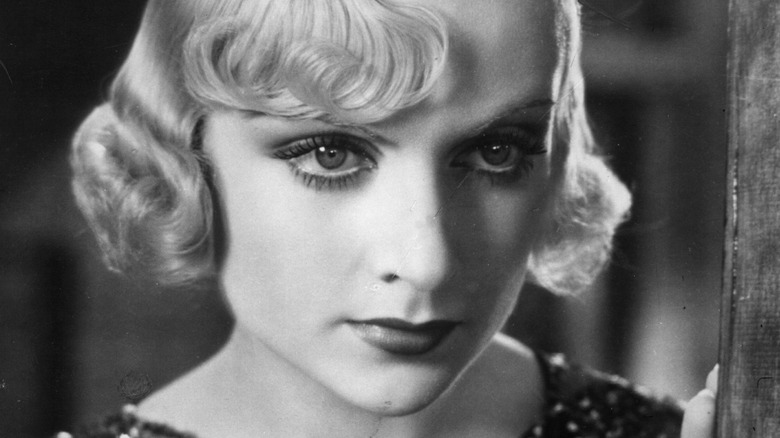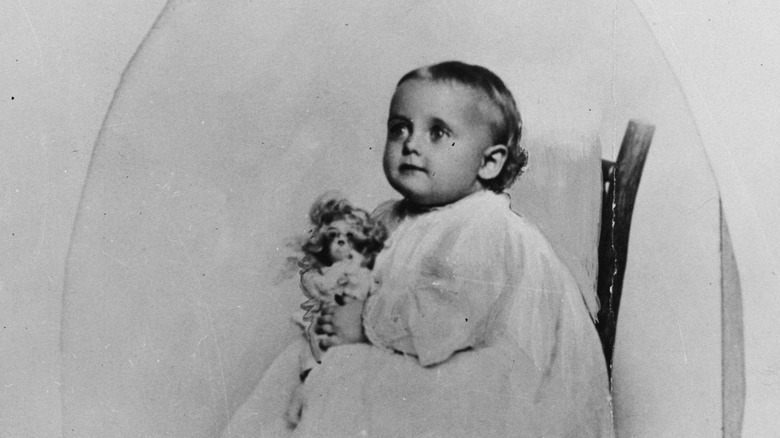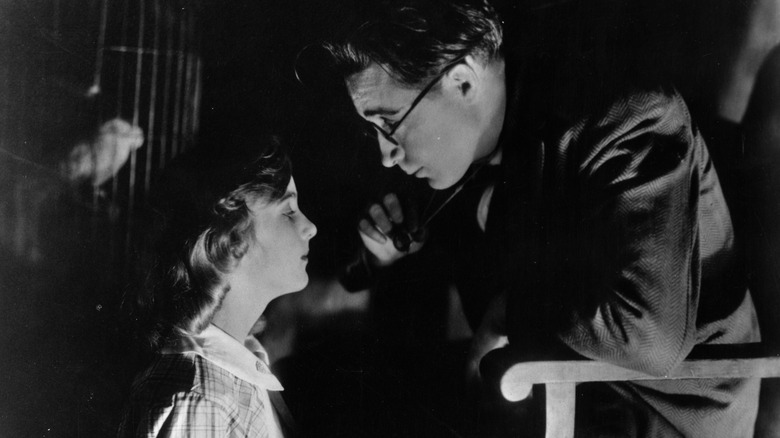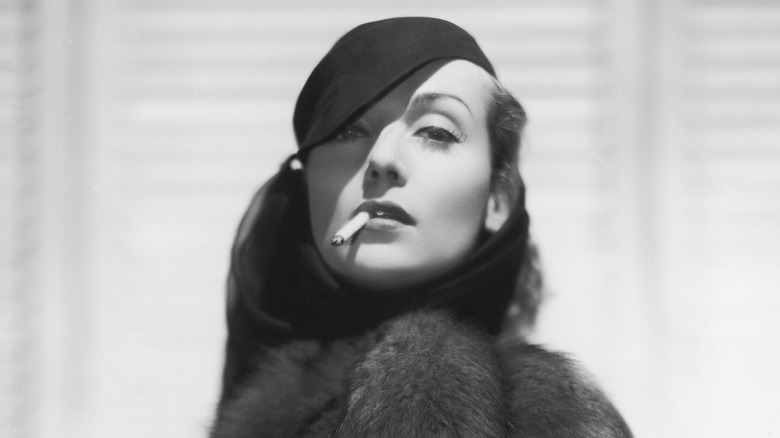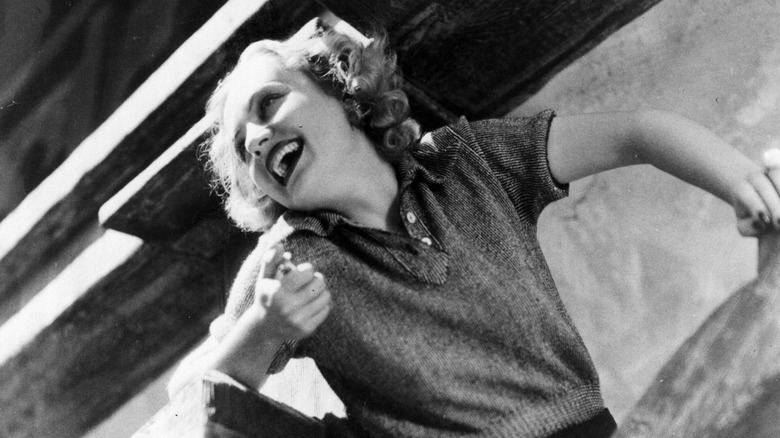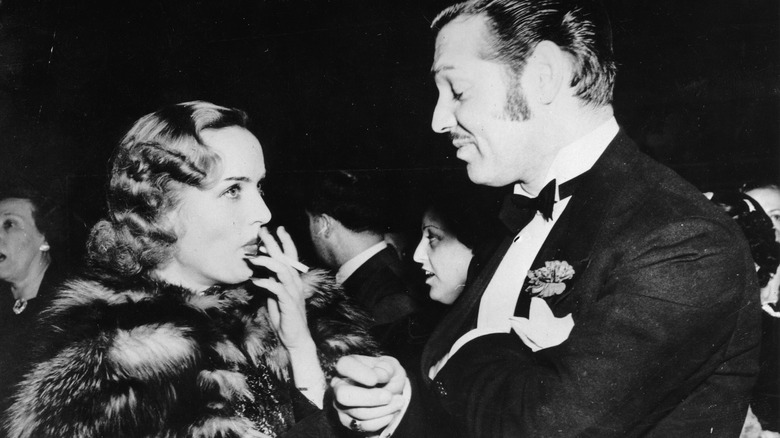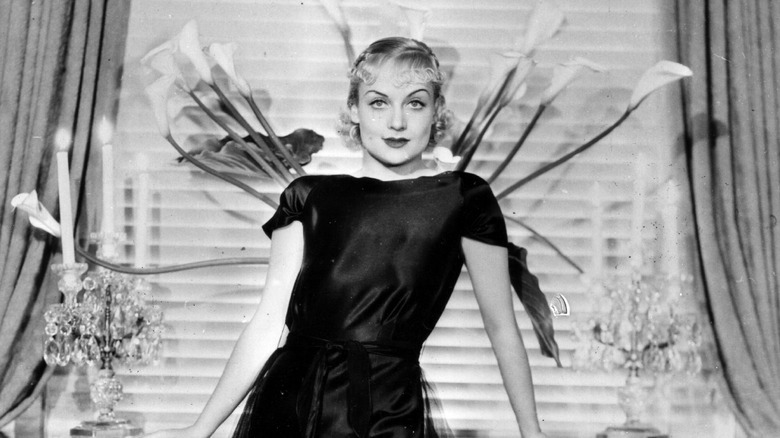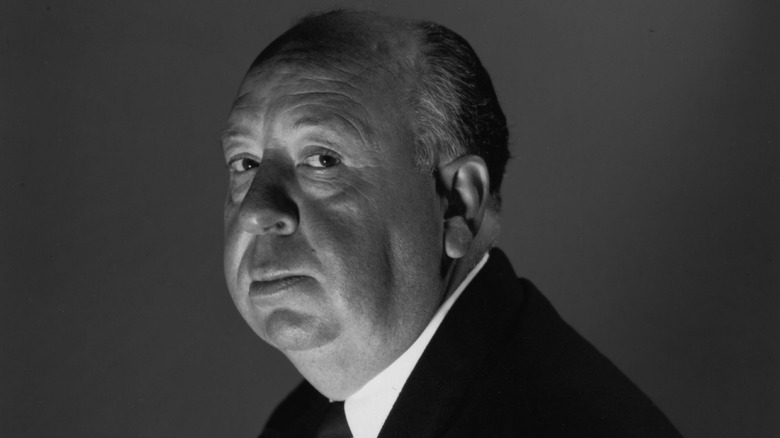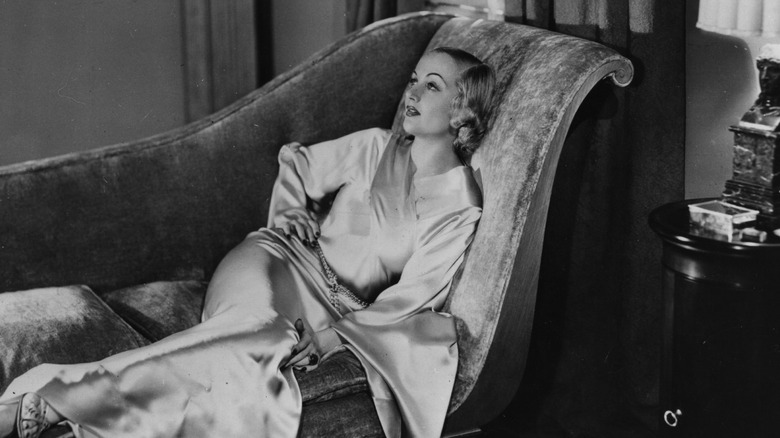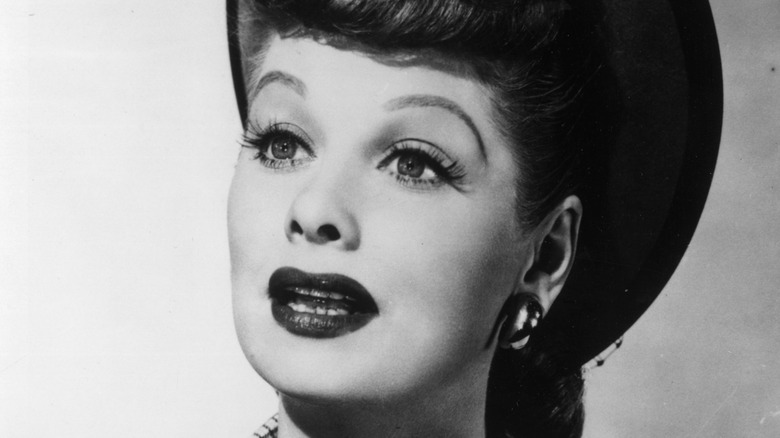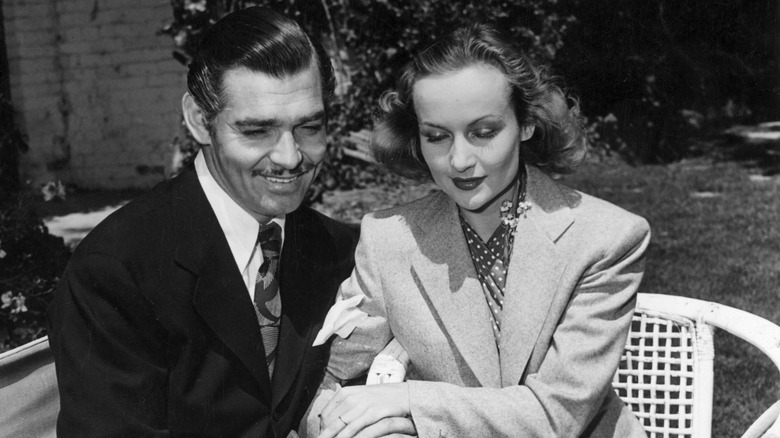The Untold Truth Of Carole Lombard
Carole Lombard was a legend among Old Hollywood's leading ladies, delighting Great Depression-era audiences with her instantly-recognizable brand of slapstick buffoonery, which, as Mubi notes, earned her the title of "queen of screwball comedy." According to TCM, what made Lombard so refreshing during the 1930s was her easygoing and unpretentious nature; she lacked none of the demanding qualities some of her more diva-centric colleagues honed shamelessly. "Carole was always there with the sunny smile and helpful hand for her co-workers," recalled screenwriter Edward F. Cline after her death in 1942, per Los Angeles Times.
While Lombard may have been beloved amongst her fans and fellow industry A-listers, her rise to the top wasn't always easy, and early on in her career in the mid-1920s, she faced an unthinkable setback — but more on that later. Nevertheless, the blonde starlet persevered; by 1937, she was making more than any other female star on camera. It seems that even after all of her success, Lombard maintained a level head and still appreciated the little things in her life. "I hope that I never lose the thrill of buying a new dress," she once mused (via Los Angeles Times).
Sadly, Lombard's life was cut tragically short when a plane crash killed her at the age of 33. Hollywood mourned the loss of one of its most cherished icons, but, of course, her legacy still remains. She lived a remarkably fascinating life, so let's dig deeper into the untold truth of Carole Lombard.
Carole Lombard came from a wealthy family and was a tomboy growing up
Born Jane Alice Peters on October 6, 1908, Carole Lombard came from a well-off family in Fort Wayne, Indiana. According to "Clark Gable: Biography, Filmography, Bibliography," although Lombard had the means to grow up as a pampered little tot, she was actually quite the tomboy, fighting to keep up with her two older brothers. Sadly, around the time the future actress was five or six, her father had a brain injury at work, leading to unprovoked, angry fits (via News-Sentinel).
As a result, Lombard's mother divorced her husband in 1914, packed her bags, and moved herself and her children to Los Angeles, where she hoped her daughter would break onto the film scene, per TCM. Around this time, the young girl still didn't have acting inspirations herself, preferring to immerse herself in the same sports her siblings played, such as football, swimming, and baseball, according to Gable's biography. In fact, as detailed in the Los Angeles Times, Lombard was so athletic in her youth that she was known as the fastest runner at her high school.
Luckily, it's Lombard's athleticism that finally got her spotted by Hollywood's bigwigs. As explained in Gable's book, one day, when the girl was 12, director Allan Dwan spotted her boxing with her brothers in her yard and was instantly mesmerized by the plucky blonde. He subsequently asked Lombard's mother if he could cast her in the 1921 comedy, "A Perfect Crime." The gig paid $50.
She didn't know anything about acting when she got her big break
Sure, Carole Lombard got her start in the 1921 silent comedy "A Perfect Crime" at the age of 12, but it wasn't until a few years later that she got her proper big break. As detailed in "Carole Lombard: Twentieth-Century Star," the star claimed that she was discovered when she was 16 at a dinner party with a studio executive one evening. Almost instantly, he arranged a screen test, yet Lombard recalled that she did an absolutely terrible job. Nevertheless, Fox Studios signed the excited actress in 1925.
"[I didn't know] a thing about acting," Lombard recalled to Movie Mirror years later (via "Carole Lombard: Twentieth-Century Star"). "I merely stood there in front of the camera and did what the director told me, and tried to keep my mind blank so I wouldn't interfere with his thoughts transmission," she added. Sadly, according to Lombard, because of this lack of experience in the business, she was removed from three films — mainly because she was constantly holding onto things, never knowing what to do with her hands.
It wasn't just her acting chops that needed some work, however. As detailed in the star's biography, her birth name, Jane Alice Peters, didn't have the star power that Fox was after, either. Thanks to two friends, she finally settled on "Carole Lombard" — although she never thought the name suited her. According to the star, the "girly" name never fit. "I was a tomboy of tomboys," she reportedly declared.
Carole Lombard faced a huge career setback early on
After signing to Fox in 1925, Carole Lombard was ready for her big break. Unfortunately, Fox wasn't on the same page as her, and as "Clark Gable: Biography, Filmography, Bibliography" notes, the studio merely considered her another one of their young actresses, leading to a lack of progress in these early days of her career.
Perhaps Lombard may have found quicker success if tragedy didn't strike a mere year after landing her contract with the legendary studio. According to The History Press, one night, the fledgling star was in the passenger seat of a car driven by her friend, Harry Cooper, when a terrible crash occurred. As the vehicle's windshield broke, a bit of glass sliced Lombard's face, leaving her with multiple scars on her cheek and eye. Taken to the hospital immediately, doctors deduced that if they stitched the actress up with an anesthetic, she might suffer even more damage due to relaxed facial muscles. As a result, they performed the operation without any.
Lombard later explained that Fox had let her go by the year's end. As revealed by Reel Rundown, when Paramount Pictures later signed her, she perfected the art of covering up her scars with the help of makeup.
She found great success as a slapstick actress
Misfortune struck Carole Lombard in 1926 after a car accident left her with visible scars on her face, and Fox subsequently dropped her. Miraculously, Lombard's determination never faltered. As Hollywood masseuse Sylvia Ulback recalled in "Carole Lombard: Twentieth-Century Star," the actress never complained about her setback. Sure enough, the blonde's positive disposition finally paid off when she was spotted by the mastermind producer of early slapstick comedies, Mack Sennett.
Per TCM, Sennett hired Lombard to appear in his low-budget, short silent films, deducing that because his movies were so farcical, nobody would notice the starlet's scars. Sure enough, she racked up roles in these physical comedies, and by 1930, she was popular enough that Paramount Pictures approached her to sign a contract — and she did. As detailed in "Clark Gable: Biography, Filmography, Bibliography," the studio swiftly enrolled their new star in acting, voice, and dance lessons, while also landing her a leading role in the 1931 drama, "Man of the World," alongside William Powell. The attraction between the two co-stars developed, and with Paramount's approval, they wed in 1931. Remarkably, during this time, the duo's combined income was $6,000 a week – at the peak of the Great Depression.
Sadly, according to TCM, Lombard and Powell's union was short-lived, and they divorced in 1933. An unphased Lombard only watched her star power rise, however, and by the late 1930s, she was at the top of her career as a freelancer, able to choose her own projects and negotiate deals with studios, per "Independent Stardom."
Sparks didn't initially fly between Carole Lombard and Clark Gable
While Carole Lombard was still married to William Powell in 1932 (they divorced the following year), she starred in the romantic drama "No Man of Her Own" alongside Clark Gable – who would later become her second husband. According to Vanity Fair, biographer Warren G. Harris claimed that the co-stars reportedly saw zero sparks fly, as the "Gone with the Wind" star found Lombard's exuberant antics irritating. In contrast, the extroverted actress thought Gable's calm reservations were dull.
Four years later, the pair was singing a different tune. Per Vanity Fair, in 1936, Lombard hosted a glamorous ball in Beverly Hills, extending invites to various A-listers, including Gable. After some flirtatious banter on the dance floor and the actor's proposition that Lombard spend the night with him, she declined the offer, instead sending him a pair of doves to his apartment as a peace offering. Although Gable was still married to Ria Langham at this point, he and Lombard quickly fell in love.
According to Country Living, the couple kept their relationship a secret until Gable's divorce was finalized in 1938, eloping the following year. A legendary Old Hollywood match, Lombard and Gable were always together and, with their demanding schedules, were never apart for longer than a week (via The Vintage News). They remained together until Lombard's tragic and sudden death in 1942.
Carole Lombard had a reputation for being quite outspoken on set
Carole Lombard reigned supreme as a comedic queen during the Golden Age of Hollywood, but she also fought incredibly hard in the notoriously misogynistic industry, too. As biographer Annette Tapert wrote in "The Power of Glamour" (via LA Weekly), even early on in the blonde's career, she refused to put up with any sort of harassment at the hands of casting directors or men on set. Lombard asked her brothers to teach her the most profane words they knew as a means of retaliation. "The lechers weren't just put off, they were left dead in their tracks," wrote Tapert.
Another Lombard biographer, Robert Matzen, told Closer Weekly that the actress' pottymouth earned her the reputation of "the profane angel of Hollywood" — but she wasn't simply defending herself. As it turned out, Lombard was even known to walk off set if she witnessed a director mistreating any other members of their crew.
Of course, this behavior wasn't exactly common in the 1930s, and both critics and fans took note. In an interview with Photoplay from 1937 (via The Screwball Girl), a reporter asked the "Nothing Sacred" star her tricks to living in a male-dominated world. "Because I don't believe it is a man's world," Lombard declared. "A woman has just as much right in the world as a man, and can get along in it just as well if she puts her mind to it."
She played a prank on the Master of Suspense himself
Celebrated director Alfred Hitchcock was known as the Master of Suspense, captivating audiences with his specific brand of macabre and anxiety-inducing horror for an incredible six decades, per Smithsonian Associates. Interestingly, he directed one romantic comedy in his career, 1941's "Mr. & Mrs. Smith," starring Carole Lombard.
As TCM explains, Hitchcock was introduced to Lombard by David O. Selznick at a social event in 1940, where the actress gushed over the Brit's work and his tendency to incorporate humor in his films. The pair swiftly built a rapport, and according to the Radio Times, the director agreed to shoot the flick as a favor to his new friend and even let her direct a scene where he made a cameo.
The same year the auteur met Lombard, he appeared in an article published by gossip columnist Heda Hopper, where she claimed that Hitchcock was difficult to work with and included an alleged quote from the director himself, where he declared that "actors are cattle," per Movies!. Lombard got wind of this quote and decided to have some fun. As Hitchcock later recalled, when he showed up on set on the very first day of shooting, he spotted a sectioned-off corral with three young cows and the sign, "Mr. Hitchcock's cattle." Upon closer inspection, each cow had a ribbon with a name: Carole Lombard, Robert Montgomery, and Gene Raymond — the stars of "Mr. and Mrs. Smith.
Carole Lombard died in a plane crash
Sadly, Carole Lombard's life was cut tragically short, and the beloved comedic star died at age 33, shortly after America began its WWII involvement in January 1942. As detailed by The Hollywood Reporter, a few weeks prior, on December 22, Lombard and her husband, Clark Gable, organized a gathering at the Beverly Wilshire hotel with the hottest actors of Hollywood. After Japan's attack on Pearl Harbor a mere 15 days earlier, the A-listers decided that they must boost morale throughout the country, and money needed to be raised.
As a result, Lombard's publicity director at MGM, Howard Dietz, asked that she head on tour in Indiana, her home state, to sell war bonds, per History. He warned the actress against traveling via plane, so she mainly stuck to train rides for the duration of the trip, ultimately raising $2 million. Gable, on the other hand, didn't make the trip with his beloved, staying in Hollywood due to his filming schedule.
When it was finally time to head back to Los Angeles on January 16, an impatient Lombard decided to take a TWA DC-3 plane back home with her mother and publicity agent. According to History, after taking off, the pilot swerved off course, and without the help of any warning beacons (which had been shut off after the bombing of Pearl Harbor), the aircraft crashed into a nearby cliff. All 22 people on board perished, and Lombard's body was later rescued by search parties.
Lucille Ball believed Carole Lombard was her 'guardian angel'
A fellow comedy icon in her own right, Lucille Ball was the famous face behind the zany 1950s sitcom, "I Love Lucy." While Ball's misadventures on camera as Lucy are still beloved to this day, her debut in Tinseltown wasn't always so glamorous, and she started her career appearing in sleazy, low-budget B movies in the 1930s (via Chicago Tribune).
Ball bounced around to various leading studios in the mid-1930s, finally getting her big break from RKO in 1937 with a role alongside Ginger Rogers and Katharine Hepburn in "Stage Door," which, inevitably, opened up even more doors for the budding starlet. By the following year, she was an A-lister. In an interview with Photoplay in 1948, Ball recalled the kindness she experienced while on set with Carole Lombard in the early days of her career. The future sitcom actress, who only had a role as an extra, remembered Lombard approaching her and declaring she had a star quality about her. "[The] greatest thing that ever happened to me is that most women like me," Ball announced, adding, "Greatest of all, Carole Lombard liked me."
Sure enough, Lombard did like Ball, even securing her the leading role in the 1942 drama "The Big Street," alongside Henry Fonda, per Chicago Tribune. Ball told Photoplay that she believed that her friend was her "guardian angel," a role Lombard maintained even after her death in 1942.
Clark Gable never quite recovered from her death
Carole Lombard's second husband, Clark Gable, had a reputation as quite the playboy during Hollywood's Golden Age. Per Biography, he married a total of five times, yet no woman captured his heart quite like the plucky, jovial blonde. After meeting in 1932 and being reintroduced a few years later, the pair kept their relationship a secret until Gable's divorce from his second wife was finalized. Finally, in 1939, they had a wedding. Truly smitten with one another, Gable and Lombard enjoyed a quiet life, forgoing the lights of Hollywood for their peaceful ranch in Encino, California (via Closer Weekly).
Sadly, their marital bliss was cut short by Lombard's fatal plane crash in 1942. As History explains, Gable was absolutely heartbroken by the tragedy, drinking heavily in his now-empty home. As legend has it, the "Gone with the Wind" star didn't care anymore whether he lived or died, so he finally enlisted in the U.S. Army Air Corps and headed to Europe, remaining for five combat missions and heading back to America in October of 1943 (via Den of Geek).
Gable mourned his wife's death for his remaining years, and although he remarried twice more, the New York Post notes that both of his wives looked a lot like Lombard. According to History, when the actor died in 1960, he was buried in Forest Lawn Memorial Park in California — right next to his beloved.
